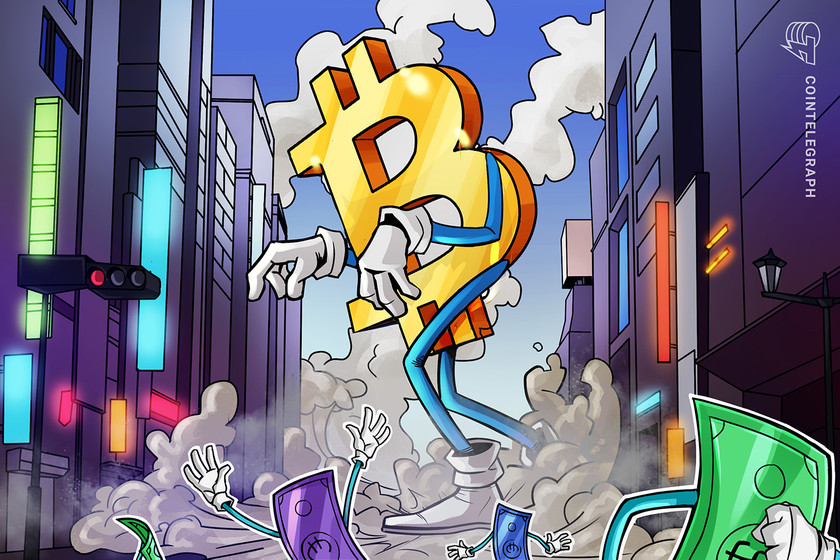UBS’s acquisition of Credit Suisse brings some good and bad for crypto


Many in Switzerland have said that UBS’ takeover of Credit Suisse was necessary to avoid a calamitous banking crisis like that seen in 2008.
On Sunday, March 19, the 167-year history of banking giant Credit Suisse ended with a takeover by the largest Swiss bank, UBS. Under pressure from the Swiss government, UBS took over its ailing competitor for 3 billion Swiss francs ($3.25 billion) — less than half the $8 billion market value of Credit Suisse just two days before, on Friday, March 17.
A day later, on March 20, shares in Credit Suisse plunged more than 60% in European trading, with UBS down 9%.
To cover any losses UBS may incur in the deal, the Swiss government will provide $10 billion. The Swiss central bank will also make a $108 billion bankruptcy loan available to the banks.
Swiss publication, the Neue Zürcher Zeitung, called the takeover the “biggest economic earthquake in Switzerland since the rescue of UBS in 2008 and the grounding of Swissair in 2001.” A rescue should prevent a crisis that spreads to other banks, akin to what happened 15 years ago after the bankruptcy of Lehman Brothers in the United States. The takeover of Credit Suisse was “necessary” not only for Switzerland but for the stability of the entire global financial system, argued Swiss Confederation President Alain Berset.
Billion-dollar merger over a weekend
The deal spurred mixed reactions in the Swiss political arena. The Free Democratic Party of Switzerland (FDP) praised it, stating that the takeover was necessary to avoid severe damage to Switzerland as a financial and economic center.
Criticism came from the co-president of the Social Democratic Party of Switzerland, Cédric Wermuth, who tweeted that nothing had changed since the 2008 financial crisis. “The whole financial system is sick and absurd,” he said, adding that the state must step in again and save it.


Marcel Fratzscher, president of the German Institute for Economic Research, believes the takeover could lead to one giant bank, which would provoke instability across the board in the event of a notional collapse.
In an interview with Die Tageszeitung, the German economist said the current situation is nowhere near as worrying as before the global financial crisis of 2008. “Today, it is the sharp increases in interest rates by the central banks that have taken many financial institutions by surprise and have led to massive losses.”
In other words, the problem today is “not systemic interdependence between financial institutions or inadequate provisioning in terms of liquidity and capital, but unusually aggressive monetary policy.”
‘Regulatory pressure is likely to increase’
“This takeover of Credit Suisse by UBS has sent many into a deep shock,” said Olga Feldmeier, co-founder of Swiss investment platform Smart Valor, speaking to Cointelegraph. Until 2014, she was an executive director and head of sales in the wealth management business at UBS.
“It had been known for a long time that things were not going so well at the bank. But who would have thought that the bank, which was once worth $80 billion, would be the subject of a $3 billion takeover by its arch-rival UBS?” According to Feldmeier, it’s not just the 50,000 employees who are shocked. The lenders have been hit even harder, especially those with a special high-grade bond type — the so-called Additional Tier 1 Capital.
Recent: Best and worst countries for crypto taxes — plus crypto tax tips
But when asked what the alternative would be, Feldmeier agreed that without this takeover, the consequences would be catastrophic. “After all, where is it safe if one of the top 30 systemically important — and Swiss — banks go bankrupt? In a systemic bank run, neither the European Central Bank nor the Fed would be able to help.”
Mauro Casellini, board member at CCA Trustless Technologies Association and, until January 2023, CEO at Bitcoin Suisse Liechtenstein and head of Bitcoin Suisse Europe, shared a similar view.
He told Cointelegraph that it was right that the government and regulators in Switzerland acted quickly to find a solution with the least possible negative impact on the market.
“Although there had been signs for some time that things were not going smoothly at Credit Suisse, it was difficult for outsiders to see just how critical the situation was. It is too early to say whether this was the right solution, but the sheer size of this new ‘super bank’ is impressive and regulatory pressure is likely to increase,” Casellini said.
The good and the bad
The banking crisis has brought some good and some bad for crypto. Despite negative macroeconomic developments, the crypto market performed well when news broke that UBS would take over Credit Suisse. Bitcoin (BTC) won the crypto rally with a gain of 15.5% (reaching $28,671 on March 22). Ether (ETH) gained 3.9%. Driven by the BTC price rally, the share prices of listed Bitcoin mining companies have risen by as much as 120% since the beginning of the year.
According to Feldmeier, it’s a positive phenomenon for crypto exchanges, both big and small. “More trading, higher sales, some of the long missed tailwind would not hurt our industry,” said Feldmeier. “This also increases the certainty that the Bitcoin cycle keeps what it promises — namely, the next bull run around Bitcoin halving in March 2024”.
The loss from clients and investors in traditional financial institutions could positively affect the crypto market as investors turn to alternative assets, such as cryptocurrencies.
However, the Credit Suisse acquisition and the fact that the banking industry faces many different risks and challenges worldwide also has a negative side. Banks are still important partners for crypto companies. If banks are not doing well, they will be even less willing to work with crypto companies or raise fees, which will not make life easier for the crypto industry.
Recent: To be or not to be: Ethics, democracy and morality in the nascent metaverse
The recent closures of fiat on- and off-ramp banks such as Silvergate and Signature, followed by the collapse of Credit Suisse, have created “significant risks for the crypto market,” said Casellini. According to the expert, it was necessary “to address issues such as regulation, security, and transparency to build trust with investors and ensure the long-term viability of the market. Regulation will help our industry in the long run to build a successful and more decentralized alternative to the traditional financial system.”
Casellini also expects to see more challenges and risks in the future due to the changing interest rate landscape and additional requirements on banks.
“It will be interesting to see how governments and especially national banks react, and whether they will save struggling banks or let them fail.”

































